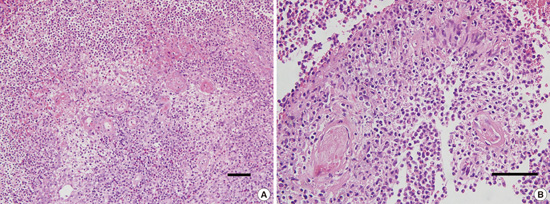1. Jennette JC. Nomenclature and classification of vasculitis: lessons learned from granulomatosis with polyangiitis (Wegener’s granulomatosis). Clin Exp Immunol. 2011; 164:Suppl 1. 7–10.

2. Hernández G, Serrano C, Porras L, Lopez-Pintor R, Rubio L, Yanes J. Strawberry-like gingival tumor as the first clinical sign of Wegener’s granulomatosis. J Periodontol. 2008; 79:1297–1600.

3. Guidelli GM, Tenti S, Pascarelli NA, Galeazzi M, Fioravanti A. Granulomatosis with polyangiitis and intravenous immunoglobulins: a case series and review of the literature. Autoimmun Rev. 2015; 14:659–723.

4. Siar CH, Yeo KB, Nakano K, Nagatsuka H, Tsujigiwa H, Tomida M, et al. Strawberry gingivitis as the first presenting sign of Wegener’s granulomatosis: report of a case. Eur J Med Res. 2011; 16:331–335.

5. Almouhawis HA, Leao JC, Fedele S, Porter SR. Wegener’s granulomatosis: a review of clinical features and an update in diagnosis and treatment. J Oral Pathol Med. 2013; 42:507–523.

6. Martinez Del Pero M, McKiernan D, Jani P. Presentation and initial assessment of ENT problems in patients with granulomatosis with polyangiitis (Wegener’s). J Laryngol Otol. 2014; 128:730–737.

7. Ponniah I, Shaheen A, Shankar KA, Kumaran MG. Wegener’s granulomatosis: the current understanding. Oral Surg Oral Med Oral Pathol Oral Radiol Endod. 2005; 100:265–335.

8. Bhatt V, Hall TJ. Strawberry gingival enlargement as only manifestation of Wegeners granulomatosis. Br J Oral Maxillofac Surg. 2009; 47:500.

9. Bajema IM, Hagen EC, van der Woude FJ, Bruijn JA. Wegener’s granulomatosis: a meta-analysis of 349 literary case reports. J Lab Clin Med. 1997; 129:17–22.

10. Troiano G, Dioguardi M, Giannatempo G, Laino L, Testa NF, Cocchi R, et al. Orofacial granulomatosis: clinical signs of different pathologies. Med Princ Pract. 2015; 24:117–139.

11. Wegener F. On generalised septic vessel diseases. By Friedrich Wegener, 1937 (translation). Thorax. 1987; 42:918–927.

12. Falk RJ, Gross WL, Guillevin L, Hoffman GS, Jayne DR, Jennette JC, et al. Granulomatosis with polyangiitis (Wegener’s): an alternative name for Wegener’s granulomatosis. Arthritis Rheum. 2011; 63:863–867.

13. Berden A, Göçeroglu A, Jayne D, Luqmani R, Rasmussen N, Bruijn JA, et al. Diagnosis and management of ANCA associated vasculitis. BMJ. 2012; 344:e26.

14. Hoffman GS, Langford CA, Specks U. Granulomatosis with polyangiitis (Wegener's). In : Hoffman GS, Weyand CM, Langford CA, Goronzy JJ, editors. Inflammatory diseases of blood vessels. 2nd ed. Chichester, West Sussex: Blackwell Publishing Ltd;2012. p. 238–251.
15. Khan AM, Elahi F, Hashmi SR, Mahida KH, Ingrams DR. Wegener’s granulomatosis: a rare, chronic and multisystem disease. Surgeon. 2006; 4:45–52.

16. Comarmond C, Cacoub P. Granulomatosis with polyangiitis (Wegener): clinical aspects and treatment. Autoimmun Rev. 2014; 13:1121–1126.

17. Patten SF, Tomecki KJ. Wegener’s granulomatosis: cutaneous and oral mucosal disease. J Am Acad Dermatol. 1993; 28:710–718.

18. Liam CK. Hyperplastic gingivitis: an oral manifestation of Wegener’s granulomatosis. Postgrad Med J. 1993; 69:754.

19. Stewart C, Cohen D, Bhattacharyya I, Scheitler L, Riley S, Calamia K, et al. Oral manifestations of Wegener’s granulomatosis: a report of three cases and a literature review. J Am Dent Assoc. 2007; 138:338–386.
20. Leavitt RY, Fauci AS, Bloch DA, Michel BA, Hunder GG, Arend WP, et al. The American College of Rheumatology 1990 criteria for the classification of Wegener’s granulomatosis. Arthritis Rheum. 1990; 33:1101–1108.

21. Savige J, Dimech W, Fritzler M, Goeken J, Hagen EC, Jennette JC, et al. Addendum to the International Consensus Statement on testing and reporting of antineutrophil cytoplasmic antibodies. Quality control guidelines, comments, and recommendations for testing in other autoimmune diseases. Am J Clin Pathol. 2003; 120:312–320.

22. van der Woude FJ, Rasmussen N, Lobatto S, Wiik A, Permin H, van Es LA, et al. Autoantibodies against neutrophils and monocytes: tool for diagnosis and marker of disease activity in Wegener’s granulomatosis. Lancet. 1985; 1:425–434.

23. Flossmann O, Berden A, de Groot K, Hagen C, Harper L, Heijl C, et al. Long-term patient survival in ANCA-associated vasculitis. Ann Rheum Dis. 2011; 70:488–582.

24. Wung PK, Stone JH. Therapeutics of Wegener’s granulomatosis. Nat Clin Pract Rheumatol. 2006; 2:192–200.

25. Semple D, Keogh J, Forni L, Venn R. Clinical review: Vasculitis on the intensive care unit -- part 2: treatment and prognosis. Crit Care. 2005; 9:193–200.
26. Hellmich B, Kausch I, Doehn C, Jocham D, Holl-Ulrich K, Gross WL. Urinary bladder cancer in Wegener’s granulomatosis: is it more than cyclophosphamide? Ann Rheum Dis. 2004; 63:1183–1188.

27. Allen CM, Camisa C, Salewski C, Weiland JE. Wegener’s granulomatosis: report of three cases with oral lesions. J Oral Maxillofac Surg. 1991; 49:294–302.

28. Alawi F. Granulomatous diseases of the oral tissues: differential diagnosis and update. Dent Clin North Am. 2005; 49:203–224.

29. Ghalayani P, Hajisadeghi S, Babadi F. Extragingival pyogenic granuloma associated with medication: Report of an unusual case. Dent Res J (Isfahan). 2014; 11:400–404.








